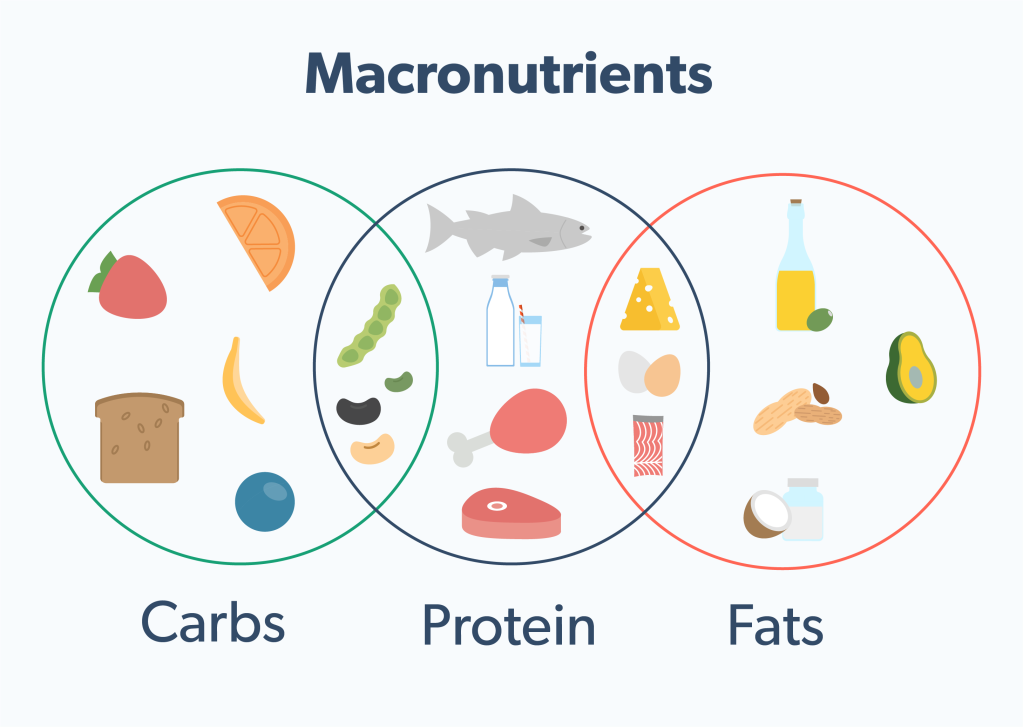There are many things we have heard about the standards for various essential substances such as vitamins and trace elements. Probably each of us has taken vitamins at some point in our lives. These substances are called “micronutrients” because their quantities are extremely small compared to the volume of food, and they do not make up any noticeable proportion of the mass of food or the energy balance of the body. But how are things with “macronutrients” – proteins, fats, and carbohydrates? Are there any “optimal” values for these food substances? Is there a mandatory minimum or a dangerous maximum? Is it bad or good to “overeat” carbohydrates? “Under-eat” fats?
As surprising as it may seem, with the exception of the necessary minimum norms of protein and essential amino acids, and two types of essential fats, all other amounts of macronutrient intake are currently an insufficiently studied area of knowledge about nutrition, causing serious disputes and differences of opinion. To this day, no specific proportions of P/F/C can be officially recommended by science as optimal for everyone. Any figures you encounter in literature may be either a private recommendation or a statistically averaged value, and may be acceptable to different people to different degrees. The concept of caloric content is the only one that is unambiguous – it is the total energy balance that determines how weight will change in the long term, almost regardless of the proportion of individual components of nutrition. Below, we will tell you about the main points related to the amount and type of various macronutrients, and give some recommendations on how to properly balance them in the diet.
Proteins
Undoubtedly, proteins are the most significant of the macronutrients. While a person can go almost without carbohydrates or almost without fats with little harm to their health (with a few exceptions), the absence of an adequate amount of protein in the diet for a few weeks, and sometimes even days, will affect all systems of the body, including the immune system, blood composition, skin quality, healing/recovery processes. The minimum intake norms of both total protein and individual amino acids have been determined multiple times, and have long been established as mandatory norms in all countries and at the international level. In most countries, they are 0.8-1 g of protein per kilogram of body weight, assuming the protein is complete (it is defined differently in different norms). In Russian norms, a diet is considered complete in protein if at least 50% of the protein comes from animal sources.
However, there is still no certainty about the upper limit of protein intake. WHO concludes that at least twice the amount of protein relative to the norm can be considered safe. In American norms, protein intake within 10-35% of energy expenditure (assuming a full ration) is considered acceptable. Numerous studies show that many people consume proteins in amounts exceeding 2 g/kg without any harmful effects. On the other hand, excessive protein intake can harm the body in cases of kidney failure or gastrointestinal disorders. This is important for those who engage in bodybuilding and other strength exercises, as despite the fact that experiments have shown that doses of protein exceeding 2 g/kg do not improve muscle growth and sports performance, many bodybuilders and athletes consume very large amounts of protein.
There are some studies about the negative impact of consuming large amounts of protein on kidney function, bone growth and health, kidney stones, and cardiovascular diseases, but most of the results are conflicting and it is currently not possible to make any definitive generalizations within the aforementioned ranges. However, it is important to remember that those consuming a lot of protein need to ensure that their body gets enough water: unlike other macronutrients, protein cannot be completely burned by the body, so unused nitrogen is bound to urea and excreted through the kidneys, a process that requires significant water expenditure.
Not everyone is able to absorb large amounts of protein. Some people can easily eat 200-300 grams of protein per day, while others struggle with even 150 grams. There are reports that in part, the ability to digest large amounts of protein is genetically determined, and some northern populations have more than 99% of the population able to easily tolerate enormous amounts of protein, by modern standards, on a daily basis.
As for the use of high protein diets for weight loss, such diets have two proven positive points:
- Proteins are the most “satisfying” macronutrient: in equal calorie portions, they provide the longest feeling of satiety and also provide the greatest “thermic effect.”
- Proteins, when they are a higher proportion of an energy deficit diet, allow for better preservation of muscle mass during weight loss.
Therefore, many weight loss methods and dieters themselves use a diet with a higher percentage of protein as the most comfortable or even more “effective” for weight loss. Although precise experiments show that the main thing is still calories, satiety, and muscle preservation, are obviously the most important factors, indirectly affecting the long-term effectiveness of the diet.
High protein diets where protein can be eaten in unlimited amounts and almost nothing else can also be popular. These diets do work because the maximum daily amount of protein that the liver and kidneys can process is 250-400 grams, which is clearly less than the daily calorie intake (2000-3000 kcal). However, those trying to live on such diets should be aware of the symptoms of protein poisoning and monitor the health of their own kidneys. Protein poisoning is often called “rabbit starvation”. It was described in the 1940s, when Arctic explorers discovered that if they only ate rabbit meat, they would suffer from diarrhea, hair loss, and eventually death, despite being adequately nourished. The cause was that rabbits have almost no fat and are almost completely protein, so their diet caused a deficiency of essential fatty acids.
Therefore, when determining your diet, keep in mind everything listed above and choose what is right for you.
Fats
The problem of adequate fat intake can be broken down into several separate issues:
- Ensuring sufficient intake of essential fatty acids (omega-6 and omega-3).
- Ensuring proper digestion.
- Optimizing the risks of various potential diseases.
Some fats (omega-6 and omega-3) are essential, meaning the body cannot synthesize them and must obtain them from food. While it is well established that these fats are essential, the exact amount of these nutrients that the body needs has not been determined. The recommended minimum intake for omega-3 fats by the FAO/WHO is 0.5% of daily calorie intake and for omega-6 fats it is 2.5%E. Severe deficiency is typically seen with intake that is several times lower, and deficiency of omega-6 fats primarily affects the skin and liver, while omega-3 deficiency can cause neurological symptoms. Different countries have slightly different recommendations for minimum intake, but it is generally believed that exceeding these recommendations can be beneficial, and so a recommended range is often established.
From the perspective of digestion, fats contribute to the absorption of fat-soluble vitamins and also improve the absorption of poorly digestible food by slowing the movement of food through the digestive tract. If you know that your current diet provides sufficient energy and micronutrients, you may not need to consider this point. However, reducing the amount of fat below 20% can be dangerous as it can increase the risk of poor absorption of other nutrients and essential fatty acid deficiency
Let’s move on to the physiological action of different fats and their effect on various risks. From the point of view of reducing blood cholesterol, especially LDL, it is useful to reduce the amount of saturated and trans fats in food. The current international standards indicate the maximum permissible 10%E of saturated and 1%E of trans fats, but it is directly recommended, if possible, to reduce their amount within the limits of a balanced diet. At the same time, polyunsaturated fats significantly reduce the amount of LDL and increase HDL. With the limitations that will be mentioned below, it is recommended to increase their proportion in food. Polyunsaturated omega-3s also reduce thrombosis, so increasing their proportion is also considered beneficial in the context of reducing CVD.
But the restrictions on the maximum amount of polyunsaturated fats, especially omega-3s, are much stronger. When consumed in excess, polyunsaturated fats lead to an increase in the process of lipid peroxidation, which destroys cell membranes. The deficiency of vitamin E exacerbates the situation. The maximum amount currently allowed by international standards is 9%E for omega-6 and 2%E for omega-3 in the form of alpha-linolenic acid (remember, these are “plant-based” omega-3s from flaxseed and soybean oil, walnuts, etc.). An additional 2 grams (according to US standards and some other countries up to 3 grams) of “long-chain” omega-3s (omega-3s from fatty fish, DHA+EPA, docosahexaenoic+eicosapentaenoic acid) is permitted.
With the exception of everything mentioned above, modern science does not have any grounds for recommendations on any specific amount of fat in food for healthy people. WHO and the majority of countries set limits on the maximum amount of fat that can be consumed daily, but they do not specify any minimum amount. The optimal amount of fat in the diet depends on the individual characteristics of the person (age, sex, physical activity, presence of chronic diseases, etc.), their dietary habits and the balance of other nutrients.
Briefly about the importance of fats for weight loss. Experiments have shown that for weight loss, the amount of fat in food does not matter, only the calorie content is important. Very often, problems with the skin, liver and female reproductive organs occur in those who are losing weight, due to the ignorance of reducing fat intake almost to zero, believing that this will positively affect their own fat. This is a very harmful misconception, food fat does not “automatically go to the side,” and such a deficiency of fats is unacceptable!
Men may be interested to know that a greater amount of fat in food increases testosterone levels, which indirectly, due to its impact on activity and muscle mass, can contribute to both weight loss and other changes in the long term.
And all those who are losing weight should also know that adding fats to food, especially protein, prolongs the feeling of satiety due to the slowing of food movement through the digestive tract.
Carbohydrates
Carbohydrates are the main source of energy for most people, but the amount of carbohydrates consumed by different people varies greatly. There is no concept of “essential” carbohydrates, like there is for proteins (essential amino acids) or fats (essential fatty acids). There is no minimal level of total carbohydrates or specific types of carbohydrates that would be dangerous for the health of most people. However, the body needs around 100g of glucose per day to meet its daily needs (primarily the brain). This is usually obtained from carbohydrate food and glycogen in the liver. When carbohydrates are not consumed in sufficient quantities for a long time, the liver produces glucose from proteins in a process called glyconeogenesis, and ketone bodies are used partially instead of glucose. This process is tolerated differently by different people; some people do not notice the absence of carbohydrates in their diet at all, while others experience symptoms such as fatigue, dizziness, and irritability. Therefore, many guidelines do not recommend reducing carbohydrate intake below about 100g unless necessary, although most people do not have problems with less carbohydrates when consuming excess protein.
But with carbohydrates, there is another, probably the main problem, and it is called “sugar.” More precisely, sugar – glucose and fructose, first of all. Humans are poorly adapted to the consumption of pure sugars, and the current wave of diabetes and other metabolic disorders (insulin resistance, obesity, metabolic syndrome) that has covered the Western world (and not only) is largely associated, first and foremost, with an increase in the amount of refined sugars in the diet.
This passage discusses the complexity of guidelines for the metabolism of carbohydrates. The rapid absorbability of carbohydrates (measured by the glycemic index or GI) can cause problems with metabolism, but this is not always directly related to the type of carbohydrate consumed. For example, overcooked potatoes or overcooked noodles have a much worse GI than raw carrots or apples, even though potatoes and noodles are formally considered “slow” carbohydrates and the sugars in carrots and apples are “fast” carbohydrates. However, if the juice is extracted from these carrots or apples, the impact on the insulin system will be similar to that of sweet soda. In this context, “external” and “internal” sugars are sometimes distinguished in classification, meaning dissolved in food and hidden behind cell walls. If the juice is extracted from these carrots or apples, the impact on the insulin system will be similar to that of sweet soda. In this context, “external” and “internal” sugars are sometimes distinguished in classification, meaning dissolved in food and hidden behind cell walls. However, lactose in milk is also one of the types of dissolved sugars, but its GI is so low that it is safe, despite the fact that it is formally classified as a sugar, and a dissolved one at that.
Therefore, the advice is not to be pleased with the indication that the product has no added sugar. It may contain its own easily accessible sugar (raisins, figs, honey) or easily digestible starch modified by heat treatment (fried potatoes, chips, baked goods). Remember that some pediatricians consider natural fresh juice for overweight children as dangerous as Coca-Cola. If you have reason to be afraid of simple carbohydrates (pre-diabetes, MS or excess weight), look not at the composition, but at the GI of the product.
However, it should be noted that according to various recommendations, the proportion of added sugars should not exceed 5…20% of the energy in the diet. The WHO says 10% which includes “added non-milk sugars,” taking into account that any dissolved sugar, except lactose, is equally dangerous with high GI. This is especially true for people who are sugar dependent: they often think that by replacing sugar and candy with dates and honey, or by drinking freshly squeezed juices instead of cola, they are avoiding the harm of sugar. Of course, this is self-deception: contrary to what is written in the advertising of “natural products” or in women’s magazines, sugar is harmful not because it is “chemically” refined, but because it has a very high GI.” Therefore, brown sugar is harmful just as much as white sugar, and honey or dates are not far behind, and if it is juice or decoction, we get approximately the same refined sugar (the essence of refining is to dissolve sugar by decoction). Therefore, despite the fact that there are no such clear norms for carbohydrates, there is a quite clear recommendation to reduce the GI of carbohydrate products, especially if the person has corresponding risks (all people with BMI> 25 have them). It is also important for those who are losing weight to know that products with a high GI provoke subsequent appetite and overeating
Fiber (dietary fiber) also belongs to carbohydrates. There are different types of it, we will not consider them in detail now. We will only recall that it is mostly not absorbed, but helps the correct operation of the intestine. It is desirable to consume the norm of fiber, especially with low calorie diets containing a small amount of food. In addition to improving peristalsis and preventing constipation, there is data on the correlation of fiber intake with a reduction in colon cancer. As with many nutrients, the tolerability of a large amount of fiber varies greatly among people. However, there is no data on the benefits of consuming large amounts of fiber, and very large amounts may worsen digestion.
Conclusion:
The only strict restrictions are the mandatory consumption of the norm of protein (and separately each of the essential amino acids) and two essential types of fatty acids – omega-6 and omega-3. Everything else is a matter of choice within wide limits.
Proteins. Consume no less than the norm. More – at your discretion, the state of the body and at the recommendation of doctors or trainers. Russian recommendations – 100-160% of the norm, American – 10-35% of calories (when maintaining the completeness of the diet), WHO considers a safe amount of protein up to 200% of the norm.
It is also necessary to obtain all essential amino acids. If your main protein is of animal origin, then you will automatically do this by fulfilling the norm of protein, if you are a vegan, then correctly balance the amino acid composition. Russian standards prescribe no less than 50% of protein from animal sources, which guarantees sufficient intake of all amino acids.
- It is important for those who are losing weight: increasing the proportion of protein gives some benefits in terms of weight loss in terms of increased satiety and reduced muscle mass loss. However, even athletes do not benefit from the amount of protein more than 2g/kg, and the additional burden on the liver and kidneys is significant at the same time.
Fats. The total amount should ideally be maintained in the range of 20-35% of daily energy. A significant excess of fat percentage may be undesirable due to an increase in the consumption of saturated fats, while insufficient consumption can lead to impaired absorption of other nutrients and a deficiency of essential fatty acids.
It is necessary to get all essential fatty acids (omega-6 and omega-3). Russian intake norms: 8-10 g/day omega-6 and 0.8-1.6 g/day omega-3. However, it is useful to get them not at the minimum norm, but significantly more, this reduces the risk of heart and vascular diseases. If your diet has a high proportion of plant and fish fats, you can be sure that you are getting enough essential fats. Since small amounts of omega-6 and omega-3 are contained in almost all food fats, if you consume a lot of fats, you are also not at risk of deficiency of essential fats. Ranges recommended by FAO/WHO: omega-6 – 2.5…9%E (5…20 g for a 2000 calorie diet), omega-3 – 0.5…2%E (1…4 g from plants + up to 2 g from fish for a 2000 calorie diet). Excessive consumption of these “useful fats” is also dangerous, but if you do not drink linseed oil or fish fat specifically, it is difficult to overdo them with ordinary food.
It is advisable to consume as little saturated and trans fats as possible, maximum norms: saturated fatty acids no more than 10%E, trans fats no more than 1%E. Saturated fats are mainly found in animal fats and also in solid vegetable fats. Trans fats come to us from margarines and special confectionery and frying fats.
- It is important for those who are losing weight: fats slow the movement of food through the digestive tract, which prolongs the feeling of satiety. This is especially noticeable on high protein foods. It is also important to know that diets with very little fat are harmful, and the amount of fat in the diet does not affect weight loss.
Carbohydrates. It is desirable not to reduce their amount to less than 100 g, which usually does not happen with a normal diet. However, in most cases, a smaller amount is also safe, consult with your doctor or coach and watch your condition. The GI of carbohydrate-containing food is desirable to reduce. Added sugars should be consumed no more than 10% of calories, and in general, the less of them the better. Do not forget that natural products can also contain a lot of easily digestible sugar, which is no less harmful than added sugar. Fiber should be consumed no less than the established norm.
- It is important for those who are losing weight: the higher the GI (rate of absorption) of carbohydrates, the more they lead to subsequent increases in appetite, feelings of hunger and likely overeating. Therefore, when on a calorie-deficit diet, it is especially desirable to reduce the GI of food, or at least reduce the amounts of fast carbohydrates in single servings. Also, when the amount of food is small, it is especially important to consume sufficient fiber (food fibers).





No Comments